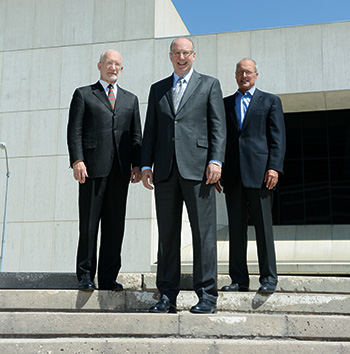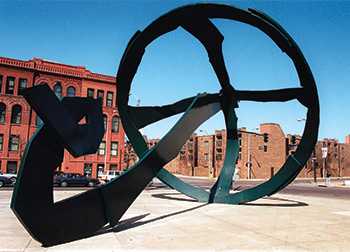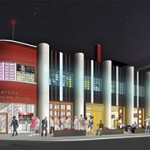
Charles Edwards has a unique perspective on the $11 million redevelopment project that he helped launch more than five years ago to replace Des Moines’ three-decades-old Nollen Plaza with the ultramodern Cowles Commons.
Edwards created the impetus for the park makeover with a pledge of a substantial donation from his family’s Gardner and Florence Call Cowles Foundation, but to understand how deep his ties are to the project, you need to go back nearly 40 years.
“I was working in the newsroom in 1974 and covering the bond vote when it failed,” said Edwards, a former publisher of The Des Moines Register. The bond issue was a community-wide vote to raise public money to replace the aging KRNT Theater with a new performing arts center.
A majority of voters supported it, but not the 60 percent needed for passage, which prompted Edwards’ uncle, Register publisher David Kruidenier, to join banker John Fitzgibbon and others to privately raise the $9 million needed to build the Des Moines Civic Center.
The center opened in 1979 and won numerous awards for its unusual design. The main theater holds 2,735 seats, the most of any concert hall in the country at the time. All are on one tier, with no balcony or dividing aisles.
As part of that original project, the city’s business leaders also created a new town square for Des Moines, called Nollen Plaza, by clearing the block immediately west of the Civic Center and developing it as an open-air plaza with green space, public art, a water feature and a concrete amphitheater.
During the next two decades, the plaza, with its amphitheater and oversized “Crusoe Umbrella” sculpture by Claes Oldenburg, became a hub for outdoor performances and public gatherings. Meanwhile, business and civic leaders worked to make over the rest of downtown, spurring development of Western Gateway Park, the East Village, the Principal Riverwalk and a revitalized Court Avenue district.
But as development and success spread outward, time and use took an inevitable toll on the Civic Center and Nollen Plaza.
The constant flow of traffic eroded the infrastructure of the building, which had become one of the nation’s most successful performance venues, ranking consistently among Pollstar’s list of the top 25 theaters in the world in terms of annual ticket sales. The plaza also took on a down-at-the-heels look over time as the pavement cracked and plumbing issues limited the water feature. With the passage of time, the park’s design moved from cutting-edge to old-hat.
Improvements Needed
A quarter century after the opening, the Civic Center’s planned maintenance fund of $500,000 to $600,000 a year—paid for by surcharges of $1.50 to $3.50 a ticket— was not keeping pace. Carpets were becoming threadbare, seats were wearing out and design changes were needed for compliance with the Americans with Disabilities Act.
In 2005, Des Moines Performing Arts President and CEO Jeff Chelesvig came up with a list of upgrades that were past due. He launched a mostly low-key campaign that raised $7 million from individuals and organizations, including $1.25 million from the state government’s Vision Iowa program and $500,000 each from Polk County and the city of Des Moines.
“One of the calls I made was on Charlie Edwards in his role as the chair of the Gardner and Florence (Call) Cowles Foundation,” Chelesvig said.
Edwards asked about Nollen Plaza, and Chelesvig admitted that he did not have a plan. “We need to get the Civic Center fixed, then we’ll address the plaza,”
he told Edwards.
But Edwards persisted, saying that he was more interested in the plaza because his uncle had pushed for Nollen Plaza as part of the original Civic Center plan. Kruidenier, who died in 2006, had realized in the mid-1970s that Des Moines did not have a town square where people could gather and informally exchange ideas. He had insisted that the plaza be part of the Civic Center plan, Edwards said.
Edwards told Chelesvig that Nollen Plaza “had fallen on hard times.” He added that once the building upgrades were completed, “the Civic Center will look great, but your front door will be a throwback to the 1970s.”
“Be careful what you wish for,” Edwards said, “because the next thing I know, we’re in a conversation about what to do.”
“You can’t patch it or Band-Aid it,” he told Chelesvig. “We’re talking about a completely new area. And if we go that route, we need to look at Millennium Park” in Chicago with its Crown Fountain designed by Spanish artist
Jaume Plensa.
“We need to see what the model for today is, because it’s much more interactive,” Edwards told Chelesvig.
The Design Team
Edwards suggested contacting architect Calvin Lewis, who had been a partner in Charles “Chick” Herbert’s firm, HLKB, when it designed the Civic Center and Nollen Plaza. Today, Lewis is a professor of architecture at Iowa State University.
“The three of us met in late 2007,” Chelesvig said. “Cal suggested that a starting point would be a design charrette,” a brainstorming session that would determine appropriate uses and functions for a rebuilt plaza.
Lewis suggested hiring New York landscape architect Ken Smith, who had designed Manhattan’s East River Waterfront, to run the charrette (pronounced shuh-ret). A native Iowan, Smith had grown up in Waukee and graduated from Iowa State University in 1976 before launching a practice in New York that does work all over the world.
Smith was intrigued. Despite his extensive resume, he had never designed a park in Iowa.
“There was room for another piece of art here that would complement the ‘Crusoe Umbrella,’ ” Edwards said, something that would be creative and interactive, like art in Chicago’s Millennium Park but on a smaller scale. Chelesvig asked Des Moines Art Center Director Jeff Fleming for the name of a cutting-edge artist, and he recommended Jim Campbell, a San Francisco artist who creates large-scale images with LED displays.
The charrette was held during the summer of 2008 on the ground floor of Capital Square, where a branch of the Des Moines Embassy Club had once looked out on Nollen Plaza. Participants included downtown residents, community leaders, elected officials and people from the arts community.
“It was a wide swath of people who came in and talked about what they liked about the plaza, what the didn’t like, and what they would like to see. It was a grueling but fascinating three days,” Chelesvig said.
On the afternoon of the second day, the charrette leaders—Campbell, Smith, Lewis and Erin Olson-Douglas, an urban designer who works for the city of Des Moines— began pulling together a rough design of ideas, which they presented to nearly unanimous approval the next day.
“Shortly after that charrette is when the financial crisis hit, and the recession started,” Chelesvig said. “We realized this would not be a good time to raise money and pushed it to a back shelf for about two years.”
Back on Track
In 2010, Edwards, Chelesvig and Lewis agreed it was time to move forward. Lewis said that the next step was to create a schematic design that could be used to put a rough overall price tag on the project so fundraising could begin.
Smith was hired to create the design, incorporating nine concepts that had been agreed upon during the charrette. Estimates put design and construction costs at about $8 million. Another $1 million was set aside for art, and a $2 million endowment was added to cover the cost of future maintenance.
The fundraising goal was set at $11 million, and an outside consultant was hired to determine the feasibility of that goal.
“Things started rolling,” Chelesvig said. “Everybody recognized that with the growth in western and eastern downtown, and this being the place that was the beginning of the resurgence of downtown, it needed to be taken care of.
“The turning point was when we ended up with $6.5 million from the Cowles Foundation and Kruidenier family and Bill Knapp,” he added. “Our challenge was to raise the additional $4.5” million.
“Knapp lent a lot of legitimacy and urgency to the project,” Edwards said, because “he was there at the time the original was done.”
Neither Edwards nor Chelesvig will say how much came from Knapp or from the Cowles/Kruidenier sources, although a knowledgeable source said the Cowles/Kruidenier pledges totaled $5 million.
With the Cowles and Knapp pledges in hand, Chelesvig asked Bankers Trust Co. President and CEO Suku Radia to host a dinner for potential donors. Radia had attended the charrette and agreed about the need to redesign the plaza as a 21st-century park.
“I called a few friends,” Radia said, “and we hosted a dinner at Splash,” a restaurant across Locust Street from the plaza. At the dinner, Smith explained the design and gathered additional input.
The fundraising never got to the level of a public campaign because individual contacts made by Radia, Chelesvig and Edwards raised the $4.5 million needed to reach the $11 million goal.
Because it was a private campaign, Chelesvig has declined to say who gave what, although he did provide a list of major donors. In addition to the Cowles, Kruidenier and Knapp contributions, the list includes Principal Financial Group Inc., Prairie Meadows Racetrack and Casino, Wells Fargo & Co., the Nix Lauridsen family, Polk County and the city of Des Moines.
“What really impresses me,” Smith said, “is the philanthropic community in Des Moines. When the city leaders decide to do something, they really figure out a way to do it and do it well.”
 A Mix of New and Old
A Mix of New and Old
The design of Cowles Commons preserves a number of the best aspects of the original plaza, including Claes Oldenburg’s giant umbrella and the diagonal connection between the front door of the Civic Center and the entrance to Capital Square, says Ken Smith, the project’s New York-based landscape architect.
That diagonal, he explained “is on the alignment of the Jefferson grid”—the true north-south, east-west grid created by Thomas Jefferson to map the Louisiana Purchase, which included Iowa. Most downtown streets are on an offset grid created by the Des Moines River, but true east-west is marked by the plaza’s diagonal line. That line will be re-created by red paving bricks that will create a red carpet between Cowles Commons and the entrance to the Civic Center, Smith said.
The redesign eliminates a wall that now separates the concrete part of the plaza from what had been a grove of trees, until they blew down in a storm last year. Also, the amphitheater and original water feature will be removed so that “the entire site can be brought up to grade and be much more usable than it was in the past,” Smith said.
Mixed native oak trees will be planted on the south portion of the plaza block, but not as thick as they were before. That area will have a native prairie floor and be flanked by “peace walls,” where famous quotations from Gandhi, Martin Luther King Jr. and others will be carved into outward-sloping 17-inch stone walls that create casual seating, he said.
James Garland, a Los Angeles-based designer, will create “an interactive water feature that will be quite extraordinary,” Smith said, but which will completely disappear when turned off. “Arches of water will come from two lines of the pavement, and they are choreographed by computer technology to create a kind of dancing water,” Smith said.
Artist Jim Campbell preferred that his light sculpture not be out in the open, like the “Crusoe Umbrella,” so it will be nestled near the trees, just south of the red-brick path. He said his work is difficult to describe but consists of bands of LED lights that are suspended from a structure that creates a curved ribbon that is about 90 feet long and 30 feet high.
“The shape … looks drastically different depending on your perspective,” Campbell said. The lights are brightened and dimmed to create low-resolution images.
Construction began early October and is scheduled to be completed in late 2014.
 Name Change
Name Change
The name of the public park directly west of the Des Moines Civic Center is changing from Nollen Plaza to Cowles Commons. The change honors Gardner and Florence Call Cowles (pronounced coles), whose family foundation provided the signature gift for the makeover. Cowles was an Algona banker who purchased The Des Moines Register and Leader in 1903 and eventually created a media empire that included Look magazine and the Minneapolis Star Tribune. He died in 1946. The name Nollen Plaza honored two brothers, Gerard and Henry Nollen. Both were Des Moines insurance executives. Gerard Nollen was president of Bankers Life Co., now Principal Financial Group Inc., from 1926 until 1946 and chairman until 1951. Henry Nollen was also an executive at Bankers Life before moving to Equitable of Iowa Cos., where he was president from 1921 until 1939.
Capital Campaigns
The $11 million raised by Des Moines Performing Arts for Cowles Commons is one of seven current or recent capital campaigns expected to raise about $93 million for local arts and culture venues. In addition to five campaigns that were active in 2013, the Des Moines Art Center in 2010 raised $34 million for a building expansion and new programing and to boost its endowment fund, and Des Moines Metro Opera in 2011 raised $6.5 million to renovate Blank Performing Arts Center in Indianola. (Though not a cultural venue, Blank Park Zoo is another major local attraction currently involved in a capital campaign. The zoo has raised more than $19 million in cash and pledges toward a $22 million goal.)
Cowles Commons
Goal: $11 million.
Purpose: To convert the city park directly west of the Des Moines Civic Center into a 21st-century park and event space and create an endowment for future maintenance and upkeep.
Status: The goal was met, and construction is scheduled to be completed by the end of 2014.
Top donors: Gardner and Florence Call Cowles Foundation, William C. Knapp, Kruidenier Charitable Foundation. Des Moines Performing Arts declined to disclose the specific amounts of the donations.

Des Moines Community Playhouse
Goal: $10 million.
Purpose: To expand and renovate the 79-year-old theater, including a new lobby and education wing and a revitalized main stage.
Status: The first phase goal of $3.4 million was reached in April and construction has begun, while a second phase effort to raise $5 million continues.
Top donors: Gabus Family Foundation, $1 million; Bankers Trust Co. and the Ruan Family Foundation, $500,000; Prairie Meadows Racetrack and Casino, $350,000; Principal Financial Group Inc., $310,000.

Des Moines Social Club
Goal: $6 million
Purpose: To convert Des Moines’ historic downtown fire station into a new visual arts and education venue for live theater, music and classes in artistic disciplines including painting, acting, singing and dancing.
Status: $5.7 million had been raised as of press time.
Top donors: Kruidenier Charitable Foundation, $500,000; Vision Iowa grant, $404,068; Kum & Go and the Krause Gentle Foundation, $350,000; the Community Foundation of Greater Des Moines, Principal Financial Group Inc., and Prairie Meadows Racetrack and Casino, $250,000 each.
Des Moines Symphony
Goal: $7.5 million.
Purpose: To install a new acoustical shell for the Des Moines Civic Center stage, make improvements at the Des Moines Symphony Academy’s spaces at The Temple for Performing Arts and increase the symphony’s endowment fund.
Status: Orchestra officials announced in May they had exceeded the goal and raised $9.8 million.
Top donors: Gabus Family Foundation, Tom and Linda Koehn, Stephen C. Smith and one anonymous donor, each $1 million or more.

Greater Des Moines Botanical Garden
Goal: $18 million
Purpose: To expand and upgrade the 1979 facility, including both outdoor gardens and interior spaces, and to boost the endowment fund.
Status: First phase goal of $10 million was reached and exceeded by $2 million in 2012; second phase goal is $6.2 million with more phases to follow.
Top donors: DuPont Co. $3 million; John Ruan Foundation and Bankers Trust Co., at least $1 million; Sue and Buz Brenton, Linda and Tom Koehn, Principal Financial Group Inc., Vision Iowa, Weathertop Foundation and Emily and Fred Weitz, $500,000 to $999,999 each.


